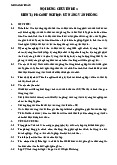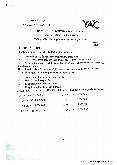



















Preview text:
Chapter 3 The adjusting process 201044 - The adjusting process Learning objectives
• Differentiate between accrual and cash-basis accounting
• Explain why adjusting entries are needed
• Journalise and post adjusting entries
• Explain the purpose of and prepare an adjusted trial balance
• Prepare the financial statements from the adjusted trial balance
• Describe the ethical challenges in accrual accounting 201044 - The adjusting process 3/10/2022 2
3.1. Why we adjust the accounts
• Accrual accounting requires adjusting entries at the end of the period
• Adjusting entries assign revenues to the period when they are
earned and expenses to the period when they are incurred
• Adjustments are needed to properly measure two things: (1) profit
(loss) in the income statement, and (2) assets and liabilities in the balance sheet 201044 - The adjusting process 3/10/2022 5
3.2. Two categories of adjusting entries
• The two basic categories of adjusting entries are prepayments (defferals) and accruals
• In a prepaid adjustment, the cash payment occurs before an
expense is recorded or the cash receipt occurs before the revenue is earned
• An accrual records an expense before the cash payment or it
records the revenue before the cash is received
• Adjusting entries fall into five types: prepaid expenses, depreciation
of non-current assets, accrued expenses, accrued revenues, unearned revenues 201044 - The adjusting process 3/10/2022 6
3.2. Two categories of adjusting entries Prepaid expenses
• Prepaid expenses are advance payments of expenses
• Examples include prepaid rent, insurance, supplies
• Prepaid expenses are considered assets rather than expenses
• When the prepayment is used up, the used portion of the asset
becomes an expense via an adjusting journal entry
Ex: Smart Touch prepays three months’ office rent of $3,000 ($1,000
per month x 3 months) on 01 June 201N 201044 - The adjusting process 3/10/2022 7
3.2. Two categories of adjusting entries Depreciation
• Property, plant and equipment assets are long-lived, non-current,
tangible assets used in the operation of a business
• As a business uses non-current assets, their value and usefulness decline
• The decline in usefulness of a non-current asset is an expense, and
accountants systematically spread the asset’s cost over its useful life
• The allocation of a non-current asset’s value to expense is called depreciation 201044 - The adjusting process 3/10/2022 8
3.2. Two categories of adjusting entries Depreciation
• The accumulated depreciation account is the sum of all the
depreciation recorded for the asset, and that total increases (accumulates) over time
• Accumulated depreciation is a contra asset
Ex: On 01 June, Smart Touch purchased furniture for $18,000. Its
expected useful life is five years. The annual depreciation amount was $3,600. 201044 - The adjusting process 3/10/2022 9
3.2. Two categories of adjusting entries Accrued expenses
• The term accrued expense refers to an expense incurred before paying for them
• Examples include accruing salary expense and accruing interest expense
• An accrued expense hasn’t been paid for yet and always creates a liability
Ex: Sheena Bright pays its employee a monthly salary of $1,800 - half
on the 17th and half on the first day of next month. 201044 - The adjusting process 3/10/2022 10
3.2. Two categories of adjusting entries Accrued revenues
• Businesses can earn revenue before they receive the cash, which creates accrued revenues
• Accrued revenue is revenue that has been earned but for which the
cash has not yet been collected
Ex: Assume that Smart Touch is hired on 16 June to perform e-
learning services for the Central Queensland University. Under this
agreement, Smart Touch will earn $800 monthly.
During June, for work performed from 16 June to 30 June, Smart
Touch will earn half a month’s fee, $400 (Assumed that the financial year ended every 30 June) 201044 - The adjusting process 3/10/2022 11
3.2. Two categories of adjusting entries
Unearned revenues (Deferred revenue)
• Some businesses collect cash from customers in advance of performing work
• Receiving cash before earning it creates a liability to perform work in
the future called unearned revenue
• The business owes a product or a service to the customer, or it
owes the customer his or her money back
• Only after completing the job will the business earn the revenue.
Because of this delay, unearned revenue is also called deferred revenue 201044 - The adjusting process 3/10/2022 12
3.2. Two categories of adjusting entries
Unearned revenues (Deferred revenue)
• Ex: A legal firm engages Smart Touch to provide e-learning
services, agreeing to pay $600 in advance for 3 months, beginning
immediately. Sheena Bright collects the first amount on 1 J une. 201044 - The adjusting process 3/10/2022 13
3.2. Two categories of adjusting entries 201044 - The adjusting process 3/10/2022 14
3.3. Two categories of adjusting entries
Ex: Information for the adjustments at 30 June 201N of Smart Touch
(a) Prepaid rent expired, $1,000 (b) Supplies used , $100
(c) Depreciation on furniture, $300
(d) Depreciation on building, $200
(e) Accrued salary expense, $900
(f) Accrued interest on loan, $100
(g) Accrued service revenue, $400
(h) Service revenue that was collected in advance and now had been earned, $200 Required:
Journalising and posting to T-accounts all the above adjustments. 3/10/2022 15
3.3. The adjusted trial balance
• Prepared after adjusting entries are posted
• Useful step in preparing financial statements
• Often appears on a work sheet (Chapter 4) 201044 - The adjusting process 3/10/2022 16
3.3. The adjusted trial balance 3/10/2022 17
3.4. The financial statements
• The income statement reports revenues and expenses
• The statement of changes in equity shows why capital changed during the period
• The balance sheet reports assets, liabilities and owners’ equity
• The financial statements should be prepared in the following order:
(1) income statement to determine profit or loss;
(2) statement of changes in equity which needs profit or loss from the
income statement to calculate ending capital;
(3) balance sheet which needs the amount of ending capital to achieve its balancing feature 201044 - The adjusting process 3/10/2022 18
3.4. The financial statements 201044 - The adjusting process 3/10/2022 19
3.4. The financial statements 201044 - The adjusting process 3/10/2022 20
3.4. The financial statements 201044 - The adjusting process 3/10/2022 21
3.5. Ethical issues in accrual accounting
• Accrual accounting provides opportunities for unethical behaviour
• For example, a dishonest businessperson could omit depreciation expense at the end of the year
• Failing to record depreciation would overstate profit as calculated by
mandated accrual principles and disclose a more favourable picture
of the business’ financial position than actually existed 201044 - The adjusting process 3/10/2022 22




